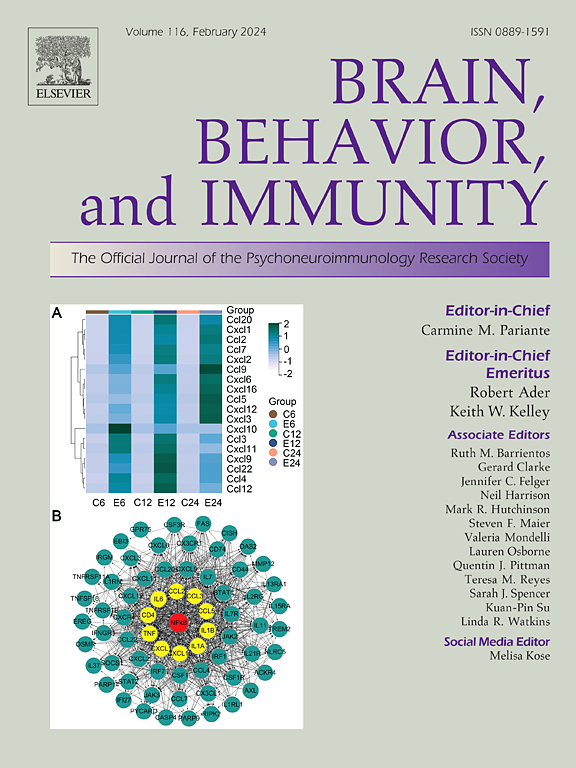A Novel Aβ B-cell epitope Vaccine, Aβ1-10 with carrier protein OVA and KLH reduce Aβ-induced neuroinflammation mediated neuropathology in mouse model of Alzheimer’s disease
IF 8.8
2区 医学
Q1 IMMUNOLOGY
引用次数: 0
Abstract
Alzheimer’s disease (AD) is a progressive neurodegenerative disorder characterized by amyloid-beta (Aβ) plaque deposition and neurofibrillary tangles, which collectively drive neuroinflammation, synaptic dysfunction, and cognitive decline. Here, we investigated whether a peptide epitope vaccine targeting the Aβ1–10 sequence could mitigate Aβ-induced pathology in AD mouse model. Three Aβ1–10 peptides, i.e. Aβ1–10-N, Aβ1–10-D1H, and Aβ1–10-S8R were synthesized, and Aβ1–10-S8R was further conjugated to ovalbumin (OVA) or keyhole limpet hemocyanin (KLH) to enhance immunogenicity. Among seven treatment groups, Aβ1–10-D1H and Aβ1–10-S8R, particularly when conjugated to OVA or KLH, effectively suppressed Aβ, amyloid-beta precursor protein (APP), and beta-secretase 1 (BACE-1) expression, decreased inflammatory cytokine production by astrocytes and microglia, and increased the levels of key synaptic markers (synaptophysin, synaptosomal-associated protein 23 [SNAP-23], postsynaptic density protein 95 [PSD-95]). Carrier protein conjugation also elevated immunoglobulin G (IgG) levels in the spleen, indicative of a robust humoral response. Taken together, these findings demonstrate that Aβ1–10-based immunization, especially with OVA or KLH conjugation, reduces Aβ-driven neuroinflammation, synaptic dysfunction, and memory deficits, suggesting a promising immunotherapeutic strategy for AD.
一种新的Aβ b细胞表位疫苗,Aβ1-10与载体蛋白OVA和KLH可减少Aβ诱导的阿尔茨海默病小鼠模型的神经炎症介导的神经病理。
阿尔茨海默病(AD)是一种进行性神经退行性疾病,其特征是淀粉样蛋白(a β)斑块沉积和神经原纤维缠结,它们共同驱动神经炎症、突触功能障碍和认知能力下降。在这里,我们研究了针对a β1-10序列的肽表位疫苗是否可以减轻a β诱导的AD小鼠模型的病理。合成Aβ1-10肽Aβ1-10- n、Aβ1-10- d1h和Aβ1-10- s8r,并将Aβ1-10- s8r与卵清蛋白(OVA)或锁孔帽贝血青素(KLH)偶联,增强免疫原性。在7个治疗组中,a- β1-10- d1h和a- β1-10- s8r,特别是与OVA或KLH结合时,有效抑制了a- β、淀粉样β前体蛋白(APP)和β分泌酶1 (BACE-1)的表达,减少了星形胶质细胞和小胶质细胞炎症细胞因子的产生,并增加了关键突触标志物(突触素、突触体相关蛋白23 [snap23]、突触后密度蛋白95 [PSD-95])的水平。载体蛋白偶联也升高了脾脏中的免疫球蛋白G (IgG)水平,表明有强大的体液反应。综上所述,这些发现表明,基于a β1-10的免疫,特别是结合OVA或KLH的免疫,可以减少a β驱动的神经炎症、突触功能障碍和记忆缺陷,这是一种有希望的阿尔茨海默病免疫治疗策略。
本文章由计算机程序翻译,如有差异,请以英文原文为准。
求助全文
约1分钟内获得全文
求助全文
来源期刊
CiteScore
29.60
自引率
2.00%
发文量
290
审稿时长
28 days
期刊介绍:
Established in 1987, Brain, Behavior, and Immunity proudly serves as the official journal of the Psychoneuroimmunology Research Society (PNIRS). This pioneering journal is dedicated to publishing peer-reviewed basic, experimental, and clinical studies that explore the intricate interactions among behavioral, neural, endocrine, and immune systems in both humans and animals.
As an international and interdisciplinary platform, Brain, Behavior, and Immunity focuses on original research spanning neuroscience, immunology, integrative physiology, behavioral biology, psychiatry, psychology, and clinical medicine. The journal is inclusive of research conducted at various levels, including molecular, cellular, social, and whole organism perspectives. With a commitment to efficiency, the journal facilitates online submission and review, ensuring timely publication of experimental results. Manuscripts typically undergo peer review and are returned to authors within 30 days of submission. It's worth noting that Brain, Behavior, and Immunity, published eight times a year, does not impose submission fees or page charges, fostering an open and accessible platform for scientific discourse.

 求助内容:
求助内容: 应助结果提醒方式:
应助结果提醒方式:


